- Publisher's Note
- Editorial
- What's Behind This Orange Facade!
- “First you are drawn in by something akin to beauty and then you feel the despair, the cruelty.”
- Art as an Effective Tool against Socio-Political Injustice
- Outlining the Language of Dissent
- Modern Protest Art
- Painting as Social Protest by Indian artists of 1960-s
- Awakening, Resistance and Inversion: Art for Change
- Dadaism
- Peredvizhniki
- A Protected Secret of Contemporary World Art: Japanese Protest Art of 1950s to Early 1970s
- Protest Art from the MENA Countries
- Writing as Transgression: Two Decades of Graffiti in New York Subways
- Goya: An Act of Faith
- Transgressions and Revelations: Frida Kahlo
- The Art of Resistance: The Works of Jane Alexander
- Larissa Sansour: Born to protest?!
- ‘Banksy’: Stencilised Protests
- Journey to the Heart of Islam
- Seven Indian Painters At the Peabody Essex Museum
- Art Chennai 2012 - A Curtain Raiser
- Art Dubai Launches Sixth Edition
- "Torture is Not Art, Nor is Culture" AnimaNaturalis
- The ŠKODA Prize for Indian Contemporary Art 2011
- A(f)Fair of Art: Hope and Despair
- Cross Cultural Encounters
- Style Redefined-The Mercedes-Benz Museum
- Soviet Posters: From the October Revolution to the Second World War
- Masterworks: Jewels of the Collection at the Rubin Museum of Art
- The Mysterious Antonio Stellatelli and His Collections
- Random Strokes
- A ‘Rare’fied Sense of Being Top-Heavy
- The Red-Tape Noose Around India's Art Market
- What Happened and What's Forthcoming
- Art Events Kolkata, January – February 2012
- Mumbai Art Sighting
- Art Bengaluru
- Delhi Dias
- Musings from Chennai
- Preview, February, 2012 – March, 2012
- In the News-February 2012
- Cover
ART news & views
“First you are drawn in by something akin to beauty and then you feel the despair, the cruelty.”
Issue No: 26 Month: 3 Year: 2012
Creative Impulse
Vrushali Dhage speaks to Susan Crile, currently a professor at Hunter College, CUNY, and a practicing artist, about her works addressing various issues related to war, terror and torture.
Vrushali Dhage: Before we move to the focus of the discussion which is on Protest Art, it would be really nice if you could give us an overview of your art practice.
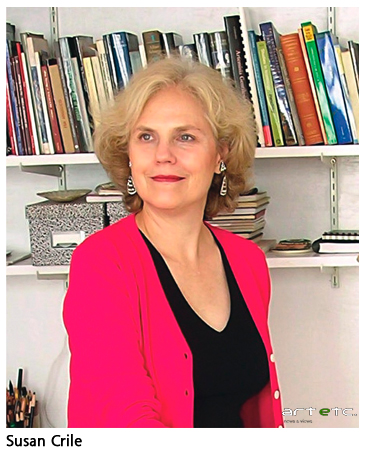 Susan Crile: My art practice is two-fold. In the late 60's I started out as a representational artist, working with still life, thinking about mortality, not unlike the Dutch still life painters. In the late 70's, and 80's I became an abstract painter and in the 90's, my work became more political. Since then, my practice has been split between, so to speak, Beauty and the Beast. My initial move into the more political realm came with the first Gulf War. I was outraged at the bombing of Baghdad, a city whose mean age was 15. I knew I wanted to do something, but it wasn’t until the oil wells were ignited that I found the entry way into making art about war. I had earlier been a landscape painter, so there was a resonance for me, even if this was the inferno. Apart from the direct political issues surrounding anything I do, there is an underlying need to reaffirm humanity. Although, it may look on the surface as if I am pointing to what it means to not be human, the vulnerability of the human condition is revealed. Getting back to the two poles of my work, the second is about beauty, those artifacts of man and the sublimity of nature that inspire in us a sense of possibility.
Susan Crile: My art practice is two-fold. In the late 60's I started out as a representational artist, working with still life, thinking about mortality, not unlike the Dutch still life painters. In the late 70's, and 80's I became an abstract painter and in the 90's, my work became more political. Since then, my practice has been split between, so to speak, Beauty and the Beast. My initial move into the more political realm came with the first Gulf War. I was outraged at the bombing of Baghdad, a city whose mean age was 15. I knew I wanted to do something, but it wasn’t until the oil wells were ignited that I found the entry way into making art about war. I had earlier been a landscape painter, so there was a resonance for me, even if this was the inferno. Apart from the direct political issues surrounding anything I do, there is an underlying need to reaffirm humanity. Although, it may look on the surface as if I am pointing to what it means to not be human, the vulnerability of the human condition is revealed. Getting back to the two poles of my work, the second is about beauty, those artifacts of man and the sublimity of nature that inspire in us a sense of possibility.
VD: As you have pointed out the second aspect of your work involves an understating of and a reaffirmation in humanity, and since the 90's there have been various political happening which have violated norms of humanity. Since you have addressed various such happenings how do you adapt a visual language appropriate to these (every independent issues/ happenings).
SC: This is a very complex issue. Communication is faster and faster. The communication modes of the 90's seem as if they were in slow motion. With the increase speed and the effluvia of imagery, we all experience a virtual overload that makes it harder for events to become deep seated in us. They barely penetrate the surface before the next one washes it away. Every event I have chosen to address has angered me or moved me deeply. The frustration and feeling of helpless makes me act.
After painting the burning oil fields, I decided that I would not move from one political horror to another, like an ambulance chaser, but instead only get involved when I was driven to it and had no choice. Consequently, each event, I have approached differently, both in the materials I use and in the way I handle them. Because the eye is such an overused sense, I look for ways to emphasize other senses (at least allude to them). Tactility is first and foremost the most important. I believe that today the locus of feeling is in the sense of touch; and additionally, the sense of tactility is what differentiates and brings to the table something very different from the virtual surface of photography, the digital and film.
VD: You have pointed out the constant inflow of new images, given this, does symbolism play a dominant role in framing the visuals.
SC: No, I think it would be closer to metaphor. For example the fires of the burning oil fields. They were more a metaphor for and stood for greater issues: they were like the beginning and the end of the earth simultaneously, as well as a metaphor for Shakespearean evil and yet on the surface, a complex sign of the failure of countries to mediate a situation. Many different levels exist simultaneously, which is true in most of the art that moves me.
VD: To add to your earlier point of tactility, can it be said that it even plays a dominant role in the process of making a visual; be it the techniques, selection of the medium or even the temporal process of working on an image…
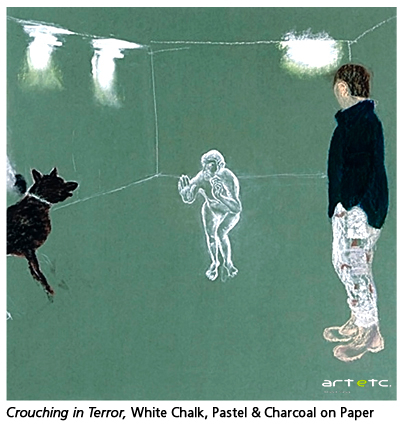
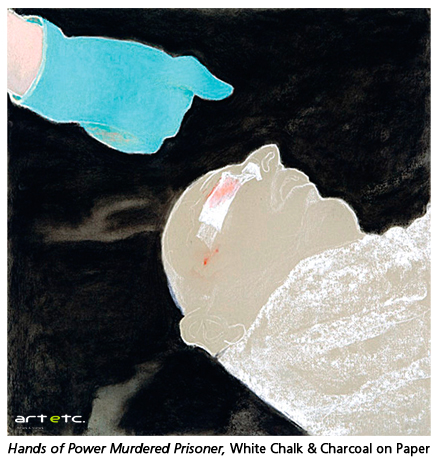
SC: The choice of materials and the kind of making is an outcome of the conceptual framework I have worked out. All of these series require a great deal of research to begin with. With Abu Ghraib, I read about pain and torture; holocaust, survivors, Susan Sontag, Elaine Scarry, Mark Danner, innumerable testimonies of prisoners, as well as Red Cross reports, Human Rights Watch. I had to get inside, empathically, what it means to be tortured. Then, when I began to work, I chose coloured papers with institutional colours, charcoal, pastels and chalk. It took a while, to find a way to represent the fragility, pain and despair of the prisoners. It was the white chalk that evoked that, with all its references to other pain: the chalk outline of the body at death scenes, the ash covering the 9/11 escapees, the white plaster casts of the human voids at Pompeii.
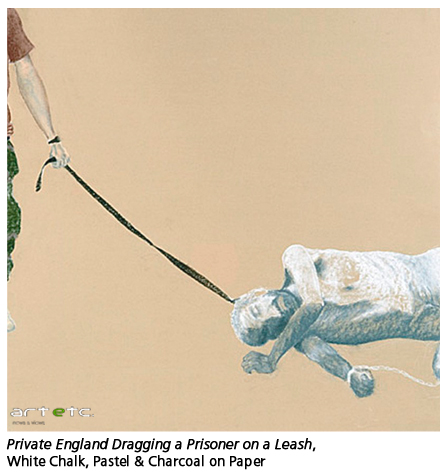 VD: Then does this too carry a metaphorical sense?
VD: Then does this too carry a metaphorical sense?
SC: Yes
VD: With photographs inundated by the media, and then being erased from the memory followed endlessly by a constant inflow of newer images (as you mentioned), do art works aim at revoking the debate, which has turned dormant?
SC: There are different kinds of art work that have different effects. The graffiti, you talk about, is art, but it doesn’t have the same purpose or resonance as just as Goya. It is meant to take possession, to assert authorship, to bring attention. It is not meant to evoke deep feeling in its visual form, although it may provoke anger about its destruction of property. I want to get under the skin, like sand in a wound; but beauty is my entry. First you are drawn in by something akin to beauty and then you feel the despair, the cruelty. The photographs from Abu Ghraib; they have become iconic: the man on the leash, the man wired, hooded standing on a box. Do we feel their pain and anguish looking at the photos now, or is just an empty representation of, "Oh, yes, that was Abu Ghraib"?
VD: It is very interesting to see how you choose beauty as a point of entry and then leading to expose cruelty, these are polarities which you blend together, could you elaborate on this.
SC: It comes back to the question- how can we effect or move another person in this digital age. Almost everyone, in every field, comes up against this issue. There is a Slow Food movement that tries to do this in relation to the food industry. It becomes a temporal issue as well, with the sped up time, ‘no time for this, no time for that’. There is no time to reflect and contemplate. For me the polarity of beauty and horror, are two sides of the same coin. There are polarities to most aspects of our life, showing both sides, the horror through the beauty is a way of slowing down this relentless fast train, maybe just for a few moments.
VD: Is it a similar case of drawing polar opposites - about sadism and humanity? Humanity - as a general concept and also through formal policies - as written codes of conducts; primarily for government officials' behaviour towards prisoners, in Abu Ghraib series.
SC: There was a two tier code. For the public, our Government blamed "a few bad apples". These were soldiers who were following instructions. Their fatal error was getting caught when their photographs of sexual abuse and torture went viral. They went to jail, not for the torture they inflicted, but for the revelation of it. The real policy and methods of torture used came from the Kubark Manual, produced decades ago by the CIA for the School of the Americas in Panama. It was used to train Latin American death squads. The same methods were used at Guantanamo and Abu Ghraib. Since leaving office as Vice President, Dick Cheney has admitted publicly and defended the right of the United States to torture. Meanwhile, no one responsible for these policies has been punished while some of the soldiers are still in jail. So the codes of conduct apply to some and not others.
VD: Protest Art does require an artist to be not just well acquainted but also rational in understanding and analysing political scenarios such that their works then become unbiased representations of the same. Could you elaborate on the mentioned point and also on the moral responsibility an artist invariably carries.
SC: We are all a part of our times, but artists, just as the rest of the population can resist looking with a clear eye at what that means. For some, politics is separate from their art. I don't think it is all one thing or another. There is an interesting balance that each of us has to find between the rational and the intuitive. And what's balance for one is not for another. One has to have an understanding of what is happening in the world, which is not always so easy to do, because there are so many layers of information, deceit and then obfuscation. For me, the question is how to find what has the ring of truth, and then how to transform it into something felt. First, the Hippocratic oath, ‘do no harm’, then to inform myself, finally to externalize and illuminate this in my art.
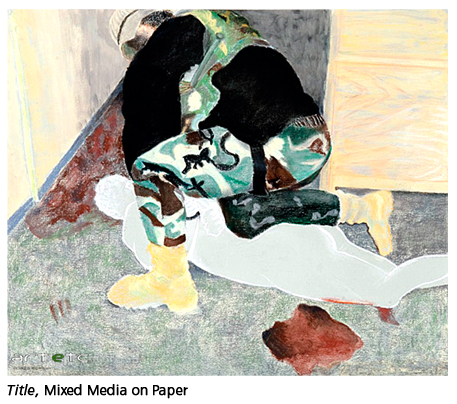 VD: Also, Protest Art has a constant threat of facing stiff opposition and censorship. How does one deal with it, as these are inevitable hurdles.
VD: Also, Protest Art has a constant threat of facing stiff opposition and censorship. How does one deal with it, as these are inevitable hurdles.
SC: In a society where the press is often complicit with the corporate thinking of its bosses, it is hard. Unfortunately, too often, the protest remains 'preaching to the converted'. That was the beauty of OWS (Occupy Wall Street); their protest was able to circumvent the usual channels and was able to be felt, precisely because it used a new form. Here, in the U.S. there is an attempt to drown out or marginalize protesting, itself. Protest art, more than facing severe opposition, is probably just ignored, unless it fits just the right requirements for the prevailing 'art' aesthetic.
VD: From a conventional viewpoint – protest is supposed to have a large impact on the masses, do you think art works housed in a gallery can do the same (as you mentioned earlier protests are of different types)?
SC: The effects are different. Street art, be it graffiti, posters, signs, performances, interventions, are by their very nature temporal. They are here and gone, if a performance (although they have legs through video) or they are thrown out, papered over, repainted. Its impact is in the moment. The work in the gallery, has a slower time frame, and may reach fewer people. Everything depends as well upon whether or not if it has a digital outlet. But certain kinds of art are compatible and look good in digital forms; others lose everything because they depend on perception, acuity, tactility, among other things. These kinds of works, among which I would include myself, require seeing the art work, itself, since they have a slower release time and need more contemplation. Yes, they have the potential to be felt, but it won’t have the grand scale public of the latest YouTube video gone viral. We still look at Goya's Third of May or his etchings The Disasters of War. Apart from arts ability to move or activate, it is also is record, a different kind of record of our time.
VD: That was a very nice way to put forward the argument. Apart from the discussion we have been having, could you tell us something about your current works?
SC: I have four different bodies of work going at this point and they are all different, divided evenly between the bright side and the dark side. I am finishing, I hope, the series called In Our Name, about Guantanamo and black sites. It is slow going because there are no images. I have to cull from testimonies, Human Rights Watch, CCR (Centre for Constitutional Rights), ACLU, what happened and where. Then I try to find imagery of place and people on the Internet and construct the drawing from these various sources. I'm getting close, but it takes a long time to make each work and its heart wrenching, so I move to something else as a break after each drawing. I have started working on drawings for a huge painting I plan to do this summer on the BP Gulf Oil spill. For the bright side, I have for several years been working on a series of small abstract paintings on wood panels with Flashe paint. At this very moment, I am working on a series of large pastels that were started in Rome this fall. I spent two months there and had a studio at the American Academy in Rome. The beautiful burnt orange and ochre walls, so associated with Rome, are being repainted as their time for painting comes due, with pale creams and pale greys. These drawings are homage and love poem to the beauty of Rome so brilliant at dusk and a protest against the academic idea of the preservationists to go back to the 'original' colour of each building.
VD: Looking forward to see these works.
All Image Courtesy: Susan Crile